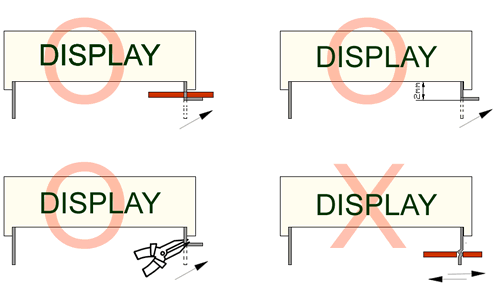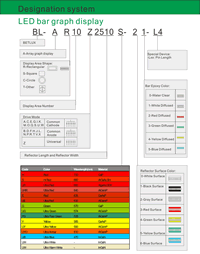 Light Bar | electtronics component
Light Bar | electtronics component
17x15mm light bar
BL-AR1Z1715


Electrical-optical characteristics:
| Part No C.C. | Part No C.A. | color | wavelength | V typical(V) | V max(V) | Brightness(mcd) |
| BL-AR1Z1715H | Red | 700 | 2.25 | 2.6 | .6 | |
| BL-AR1Z1715D | Super Bright Red | 660 | 1.85 | 2.2 | 11 | |
| BL-AR1Z1715S | High Bright Red | 660 | 1.85 | 2.2 | 6 | |
| BL-AR1Z1715UR | Ultra Bright Red | 660 | 1.85 | 2.2 | 20 | |
| BL-AR1Z1715E | Orange | 635 | 2.1 | 2.5 | 6 | |
| BL-AR1Z1715UE | High Bright Orange | 630 | 2.1 | 2.5 | 11 | |
| BL-AR1Z1715Y | Yellow | 585 | 2.1 | 2.5 | 6 | |
| BL-AR1Z1715UY | High Bright Yellow | 590 | 2.1 | 2.5 | 11 | |
| BL-AR1Z1715G | Green | 570 | 2.2 | 2.5 | 6 | |
| BL-AR1Z1715UG | High Bright Green | 574 | 2.2 | 2.5 | 11 | |
| BL-AR1Z1715PG | Super Pure Green | 525 | 3.0 | 4.2 | 14 | |
| BL-AR1Z1715B | Super Bright Blue | 470 | 3.0 | 4.2 | 12 | |
| BL-AR1Z1715UB | Super Bright Blue | 470 | 3.0 | 4.2 | 22 |
Package configuration & Internal circuit diagram
Tolerance is +-0.25(0.01") unless otherwise note
Specifications are subject to change without notice.
Absolute maximum ratings (Ta= 25?C)
Reflector Surface color (1st number)/ Bar Lens color (2nd number):
| Number | 0 | 1 | 2 | 3 | 4 | 5 |
| Ref Surface Color | White | Black | Gray | Red | Green | |
| light bar Epoxy Color | Water clear | White diffused | Red Diffused | Green Diffused | Yellow Diffused |
Absolute maximum ratings (Ta= 25°C)
| Parameter | S | D | UR | E | Y | G | Unit | |
| Forward Current IF | 25 | 25 | 25 | 25 | 25 | 30 | mA | |
| Power Dissipation Pd | 60 | 60 | 60 | 60 | 60 | 65 | mW | |
| Reverse Voltage VR | 5 | 5 | 5 | 5 | 5 | 5 | V | |
| Peak Forward Current IPF (Duty 1/10 @1KHZ) | 150 | 150 | 150 | 150 | 150 | 150 | mA | |
| Operation Temperature TOPR | -40 to +80 | °C | ||||||
| Storage Temperature TSTG | -40 to +85 | °C | ||||||
| Lead Soldering Temperature TSOL | Max.260+ 5°C for 3 sec Max. ( 1.6mm from the base of the epoxy bulb) | °C | ||||||
Absolute maximum ratings (Ta= 25°C)
| Parameter | UHR | UE | YO | UY | UG | PG | UB | UW | Unit |
| Forward Current IF | 30 | 30 | 30 | 30 | 30 | 30 | 30 | 30 | mA |
| Power Dissipation Pd | 75 | 65 | 65 | 65 | 75 | 110 | 120 | 120 | mW |
| Reverse Voltage VR | 5 | 5 | 5 | 5 | 5 | 5 | 5 | 5 | V |
| Peak Forward Current IPF (Duty 1/10 @1KHZ) | 150 | 150 | 150 | 150 | 150 | 150 | 100 | 100 | mA |
| Operation Temperature TOPR | -40 to +80 | °C | |||||||
| Storage Temperature TSTG | -40 to +85 | °C | |||||||
| Lead Soldering Temperature TSOL | Max.260+ 5°C for 3 sec Max. ( 1.6mm from the base of the epoxy bulb) | °C | |||||||
Partno description:
LED light bar is widely applied in instrument show box, elevator,etc
Applied for:




1. Application
The Light bar display is widely applied for ordinary electronic equipment (such as office equipment,
communication equipment and household applications). Checking with BETLUX's Sales in
advance for information on applications in which exceptional reliability is required, particularly
when the failure or malfunction of the LED light bar display may directly jeopardize life or health (such as in
aviation, transportation, traffic control equipment, medical and life support systems and safety
devices).
2. Storage
The storage ambient for the LED bar display should not exceed 30℃ temperature or 70% relative humidity.
For extended storage out of their original packaging, it is recommended that the light bar LED display be stored
in a sealed container with appropriate desiccant, or in a desiccator with nitrogen ambient.
3. Cleaning
Avoid using any unspecified chemical solvent to clean LED . For example, Trichloroethylene, Chlorosen, Acetone, and Diflon S3MC.
Any cleaning method can only be taken under normal temperature in one minute or less if it is required.
Use water to clean the Light bar display if necessary under room temperature
dry it immediately after that.
4.Forming
Any unsuitable stress applied to the epoxy may break bonding wires in LED light bargraph display
Any forming on lead pin must be done before soldering, not during or after soldering.
Avoid applying any stress to resin in order to prevent the epoxy fracture and break on bonding wire.
While forming, please use a tie bar cut or equivalent to hold or bend the pin.
2mm from the base of resin is the minimum distance for the place bending the lead pin.
Avoid bending the lead pin at the same point twice or more.

Soldering
When soldering, leave a minimum of 2mm clearance from the base of the base of the lens to the soldering point. Dipping the lens into the solder must be avoided.
Do not apply any external stress to the lead frame during soldering while the LED is at high temperature.
Recommended soldering conditions:
| Wave Soldering | Soldering Iron | ||
| Pre-Heat | 100°C Max. | Temperature | 300°C Max. |
| Pre-Heat Time | 60sec Max. | ||
| SolderWave | 260°C Max. | Soldering Time | 3sec Max.(one time only) |
| Soldering Time | 5sec Max. | ||
Note: Excessive soldering temperature and/or time might result in deformation of the LED lens or failure of the LED
Static Electricity or power surge will damage the LED.
Suggestions to prevent ESD damage:
n Use a conductive wrist band or anti-electrostatic glove when handling these LEDs
n All devices, equipment, and machinery must be properly grounded
n Work tables, storage racks, etc. should be properly grounded
n Use ion blower to neutralize the static charge which might have built up on surface of the LED's
plastic lens as a result of friction between LEDs during storage and handling
ESD-damaged LEDs will exhibit abnormal characteristics such as high reverse leakage current,
low forward voltage, or “no light on” at low currents. To verify for ESD damage, check for “light on”
and Vf of the suspect LEDs at low currents.
The Vf of “good” LEDs should be>2.0V@0.1mA for InGaN product and >1.4V@0.1mA for AlInGaP
product.

tag drive bar







 箭頭指示燈
箭頭指示燈  光柱
光柱  光塊
光塊